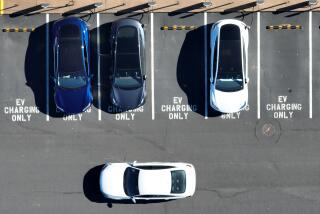Bush Proposes $105-Billion Highway Plan
WASHINGTON — The Bush Administration on Wednesday unveiled a five-year, $105-billion program to expand and improve the nation’s deteriorating bridges and highways and to encourage construction of urban mass transit systems.
Billed as one of President Bush’s major domestic initiatives, the proposed legislation would earmark $87 billion for highways and bridges, $16.3 billion for urban mass transit and $2.3 billion to promote safety programs, with a particular focus on combatting drunk driving.
A little more than $22 billion of the highway funds would be set aside in a special program that would allow states to spend their share of the money on transit systems, if they wish.
“The future of America’s transportation rests on the new foundation that we’re laying today,” Bush said at a White House ceremony attended by Transportation Secretary Samuel K. Skinner. He called the proposed legislation, known as the Surface Transportation Assistance Act, the “first step on a long road that lies ahead.”
But the proposal came under immediate fire from environmental and transit organizations, who complained that the plan emphasizes cars at the expense of mass transit. State transportation officials and leaders of key congressional committees expressed concern that the proposed funding level would be insufficient and that states would have to bear too large a burden in matching federal funds.
The money represents a nearly 40% increase in highway funding. But while it calls for an increase of 25% in capital programs for mass transportation systems, it also reduces, by nearly the same percentage, federal operating subsidies for mass transit.
The largest share of the highway money--about $43.5 billion--would be used to create a 150,000-mile National Highway System. The system would include all 43,000 miles of existing interstates, and the remaining miles of major highways would be created primarily by expanding and improving existing state roads.
These roads would be selected in consultation with state and local officials, who would be required to come up with funds to augment Washington’s contribution of 60% to 75% of the cost.
Rep. Robert A. Roe (D-N.J.), chairman of the House Public Works and Transportation Committee, said that the proposal “has some good ideas but I am concerned that, in some cases, they are masking reduced funding with philosophy and rhetoric.”
Roe noted that the states would have to raise their share of funding for some road improvements from the existing 25% to as much as 40%.
“I don’t know how the states, with all their financial problems, are going to come up with the money that’s needed,” he said.
Sen. Frank R. Lautenberg (D-N.J.), chairman of the transportation subcommittee of the Senate Appropriations Committee, said that he fears the Administration is seeking to “transfer the burden for rebuilding our nation’s infrastructure to the states.”
Lautenberg said that “the job is too formidable and too closely linked to the performance of our national economy” to permit such burden shifting.
Rep. Norman Y. Mineta (D-San Jose), chairman of the surface transportation subcommittee of the House Public Works and Transportation Committee, said through an aide that he wants to study the bill in more detail. But he said: “I have been concerned that the Administration would shift a great deal of program responsibility to the states and require them to meet federal rules without shifting sufficient funds to go along with it.”
In Sacramento, officials said it was not yet clear how California would fare financially under the proposed legislation. But they, too, expressed some reservations.
Carl Williams, assistant director of Caltrans, said that the bill “would give us a lot more flexibility in deciding what has to be done,” although not as much as some officials had hoped. Williams said he likes the fact that the Bush proposal encourages private investment in the construction and management of toll roads.
“There is just not enough money at any level of government to provide for all of our transportation needs,” Williams said. He said his main concern is that, by increasing the national highway system to as many as 150,000 miles, the federal government may not have enough money to help fund state and local projects.
Much of the funding for the bill would come from the federal Highway Trust Fund, which is supported by motor fuel taxes. Congress recently approved a 5-cent hike in the federal gasoline tax as part of its deficit-reduction agreement with the White House.
Of this increase, 2.5 cents has been earmarked for the general treasury to reduce the nation’s budget deficit, another 2 cents for highway projects and half a cent for mass transit programs.
But the Environmental Defense Fund protested that, under the Bush proposal, each state’s share of federal highway funds would be based largely on its fuel consumption, as reflected by fuel-tax figures. This factor could jeopardize air quality improvements in large urban areas like Los Angeles, the fund said.
“States that reduce gasoline consumption through ride pools, high occupancy vehicle lanes, transit and other creative measures would actually be penalized by receiving a reduced share of federal highway funds,” remarked Bill Roberts, the fund’s legislative director.
But Skinner told reporters that the bill encourages mass transit programs by proposing a shift in federal support from operating subsidies to more capital spending.
All mass transit programs will be funded through the trust fund, Skinner said, adding: “This will more equitably distribute user fee revenues and will provide state and local decision-makers with a more predictable and stable federal funding source.”
But Jack R. Gilstrap, executive vice president of the American Public Transit Assn., blasted the plan as “a recipe for more traffic jams, air pollution and wasted energy.”
Gilstrap said that the bill, unless rewritten in Congress, “continues to emphasize the movement of cars and not people by proposing a no-growth policy for mass transit but a 40% increase in federal highway spending.”
“Yes, there is a recognition of the federal role in transit,” he acknowledged. “But where is the balance?”
Responding to criticism that mass transit would be shortchanged under the program, White House Press Secretary Marlin Fitzwater said late Wednesday: “This is an age-old kind of concern and a trade-off that they have had to make since day one.
“I don’t think there’s much question about the need for a highway system and about the Americans’ desire for the independence that that provides,” he said.
“Similarly, we do have an urban mass transit fund that was set up by Congress some years ago that is providing billions of dollars to mass transit. And I think what you see here is a normal kind of special interest jockeying for funds . . . but I doubt very much that the balance is upset by this proposal,” Fitzwater said.
The program calls for increasing funds for transportation each year, providing $18 billion in 1991 and nearly $24 billion by 1996.
Staff writer James Gerstenzang contributed to this story.
More to Read
Sign up for Essential California
The most important California stories and recommendations in your inbox every morning.
You may occasionally receive promotional content from the Los Angeles Times.









